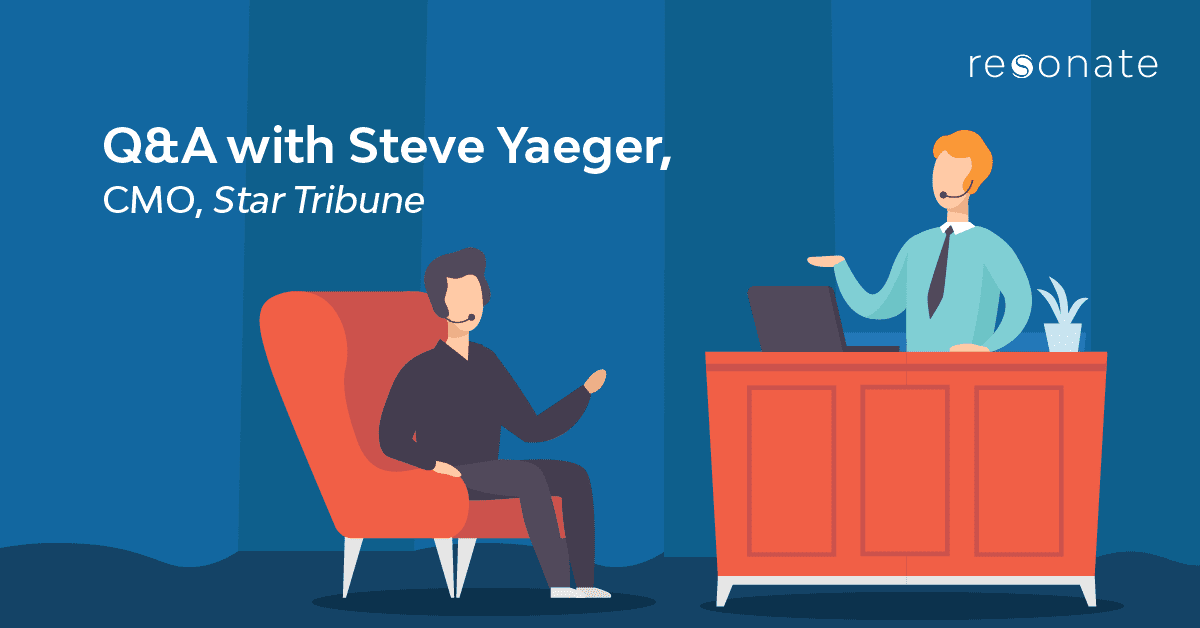Long gone are the days of media companies just competing against each other. Consumers are absorbing news in multiple ways, and traditional media must develop fresh and innovative solutions for engaging with their audiences and advertisers.
Star Tribune, the fifth largest newspaper in the country, tapped into Resonate’s consumer intelligence platform to better understand its 275,000 print and digital subscribers and to learn how and where to engage prospective subscribers outside of Star Tribune’s virtual walls. We recently chatted with Steve Yaeger, Star Tribune’s Chief Marketing Officer, to hear more about how deep consumer insights impact a publisher’s revenue and subscriber growth.
Resonate: How is Star Tribune using Resonate’s insights to drive content?
Steve Yaeger: We use it less for content development and more for telling about my audiences’ habits and preferences. For example, our subscribers are four times more likely to be on LinkedIn than on Facebook or Twitter. That was eye-opening and inspires a conversation with our managing editor about content strategy, not about story types. My marketing team puts energy and resources into Facebook as a vehicle to engage people and get them over the hump as subscribers. We’re missing an opportunity, or at least have our resources misallocated if my subscribers index so much higher on LinkedIn.
My team also makes use of the content that our newsroom produces to chase potential subscribers. We’re using Resonate tags on our site to look at what’s attracting people and what’s resonating with people and using that content to get readers in our newsroom’s wake and amplifying and recirculating content to attract readers and hopefully convert them.
Resonate: Have you changed your messaging or the types of offers you make to prospective subscribers based on Resonate’s insights?
Steve: We’re at the front end of that, and the audience insights help us narrow in on specific things that we could target or message to. We’re always testing different things. For example, Resonate’s insights show that our subscribers are heavy users of sports apps, even more so than news apps. We’re thinking through what that means in terms of offer placement and targeting.
Resonate: Could you quantify that ROI in the advertising sales process?
Steve: What our sales team shares with advertisers from Resonate either validates what they know about their audiences or opens their eyes to things they didn’t know. The Resonate information we share with advertisers is strengthening relationships and leading to renewals.
Resonate: What other impact has the platform had for Star Tribune?
Steve: We bring in new marketing and creative agencies to refresh our thinking and help us create new offers and programs. We’re able to get them up to speed on our audiences very quickly because of the quality of Resonate’s reports, which match up with data I’ve been looking at from our other partners. I think about a day when I might be able to turn off those other expenses and rely on a smaller portfolio of partners like Resonate.
Resonate: What’s another big challenge you’re grappling with right now as a media company?
Steve: There’s a whole giant ecosystem of media companies operating in the subscription economy. We’re all going after a finite number of households and there’s a limit for how many digital subscriptions they’re willing to purchase. If you think about who’s targeting a household in Minneapolis/St. Paul, it’s not only the news media, but it’s also Amazon Music, Apple Music, Spotify, Sirius, Netflix, Hulu. These companies are vying for the same finite pool of subscribers in my market to pry loose a certain amount of their digital subscription budget per month. I need to understand the intersections between what I offer as a subscription product and what all these others are offering. The struggle is going to be to break that relevance barrier and end up in that tier of four, five, six subscriptions.
Resonate: Have you realized the potential of using our research as a way of having a more streamlined research partner stack?
Steve: For sure. It’s not, ‘Now I get this data from Resonate so I can drop this thing.’ It’s that the data I get is better, more relevant, more interesting. I don’t have a source that could have given me that insight about LinkedIn usage. It’s the stuff that’s new and different and more valuable that pulls you in the direction of Resonate.
Another way that we’re starting to use Resonate is I have a sizable reader panel of 2,500 regular Star Tribune readers who agreed to be surveyed regularly about our content, our advertising, our products, our services, etc. The data I get from that panel largely reflects the sentiments of a print reader. Before Resonate I didn’t have a way to understand what our digital reader thinks of that same content on our digital platforms. Now I have a much more well-rounded view of how our audience is responding to a given type of content or story. It’s a much richer picture for editors of how our audiences are responding to the work they’re doing.
Resonate: What’s your current market size and how are you expanding?
Steve: Today about 15% of my subscribers come from outside the core Twin Cities metro area, but this year we’re investing in attracting more subscribers in greater Minnesota outside the metro. We’re going into at least one market with a pilot product. Resonate will figure in there somehow in terms of how we look at and target that market.
Get the whole story of how Resonate helped Star Tribune innovate and retain 80% of its advertisers with deep consumer insights.
Learn more about how deeper consumer insights are fundamental to the success of your business and request a demo.



